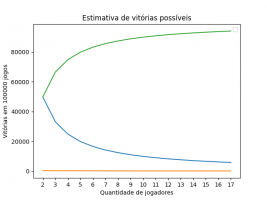I have a question about the probability of winning a score based game.
It's a game of dice and cards, the rules are:
I would like to know how to start developing this problem. Where can I learn more about the subject? How do I check for all possible games whe you would win.
It's a game of dice and cards, the rules are:
- There are 2 to 17 players (including you).
- Each person rolls two 6 faced dice.
- Each person extract 3 cards from a full standard 4x13 cards deck
- If the die results in an odd number add a³ points to the player, where a is the number on the die face.
- If it's even, add a² - 1 points.
- Add b² if b ∈ {2, 3, 4, 5, 6, 7, 8, 9, 10}, where b is the value of the card.
- If the card is an A, add 0.
- If the card is J, add 1.
- If Q, add 2.
- And for K, add 3.
I would like to know how to start developing this problem. Where can I learn more about the subject? How do I check for all possible games whe you would win.
Last edited:

